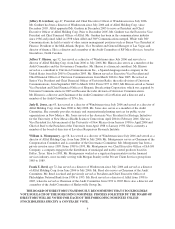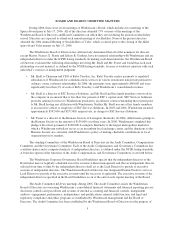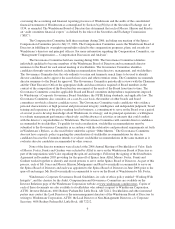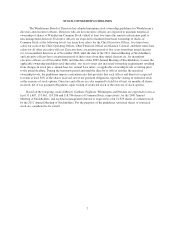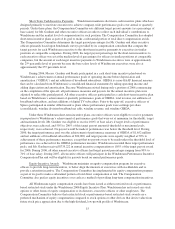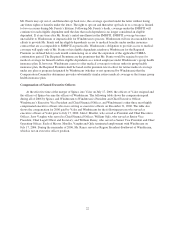Windstream 2006 Annual Report Download - page 18
Download and view the complete annual report
Please find page 18 of the 2006 Windstream annual report below. You can navigate through the pages in the report by either clicking on the pages listed below, or by using the keyword search tool below to find specific information within the annual report.
Mr. Gardner’s compensation based on an evaluation of a number of factors, including historical compensation
and performance of Mr. Gardner, discussions with Windstream management including Mr. Gardner,
compensation survey data, and discussions with the compensation consultant. The Windstream Board approves
or, in the case of Mr. Gardner’s compensation, ratifies the actions of the Compensation Committee.
The Compensation Committee has the sole authority to retain and terminate any executive compensation
consultant to be used in the evaluation of director, CEO or executive officer compensation and to approve the
consultant’s fees and other retention terms. During 2006, the Compensation Committee directly engaged Watson
Wyatt & Company to assist the Committee in the review and design of Windstream’s executive compensation
program, to provide information on competitive market practices and survey data for both plan design and
compensation levels, and to advise on the design and terms of Mr. Gardner’s employment agreement, the
change-in-control agreements for executive officers, and a non-qualified deferred compensation plan. In June
2006, the Spinco Compensation Committee selected Watson Wyatt & Company to serve as its compensation
consultant based on the preferences of the Committee’s members. Prior to such selection, Alltel had engaged
Watson Wyatt & Company to assist Spinco in connection with compensation matters related to the spin-off and
merger.
Elements of Compensation. The compensation of Windstream’s executive officers consists of three
principal components:
• Base salary;
• Short-term cash incentive payments; and
• Equity-based compensation.
The compensation program for all executive officers also includes the Windstream 2007 Deferred Compensation
Plan, the Windstream 401(k) Plan, a change-in-control agreement, and other perquisites. Windstream has also
entered into an employment agreement with Mr. Gardner, and certain executive officers are eligible to participate
in the Windstream Pension Plan and the related Windstream Benefit Restoration Plan.
The Compensation Committee considers the total compensation of each executive officer, including
Mr. Gardner, as well as the allocation of compensation among base salary, short-term incentive compensation,
and equity-based compensation. In order to achieve the objective of providing competitive compensation to its
executives, the Compensation Committee attempts to provide total compensation to each executive officer that is
at the median (or 50th percentile) level of compensation for officers in similar positions at comparable companies.
The Compensation Committee believes that a substantial portion of executive compensation should be at risk
through allocation of compensation to short-term cash incentives and long-term equity-based incentives. During
2006, approximately 71% of total direct compensation to named executive officers as a group was comprised of
either short-term incentives or equity-based compensation, and approximately 52% of total direct compensation
was comprised of equity-based compensation. Total direct compensation for these purposes equals base salary,
short-term cash incentive payment at target levels and the full up-front fair value of equity-compensation awards
determined in accordance with Statement of Financial Accounting Standards (“SFAS”) 123(R), “Share-Based
Compensation” (“SFAS 123(R)”).
Base Salary. The Compensation Committee determines base salary primarily based upon benchmark
surveys provided by its compensation consultant that compare the base salary of individual executives to the
salary of executives in similar positions at comparable companies. During 2006, the base salary of Windstream
executives, including Mr. Gardner, was at approximately the 25th percentile of base salary level of officers in
similar positions at comparable companies. Base salary was set below the median level in part because most
Windstream executives are new to their positions due to changes in their roles and responsibilities as a result of
the spin-off and merger. Base salary is designed primarily to provide competitive compensation that reflects the
contributions and skill levels of each executive.
14


